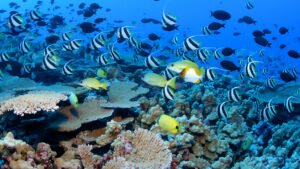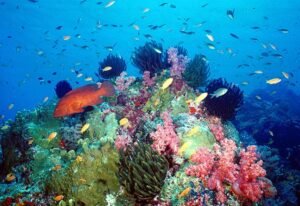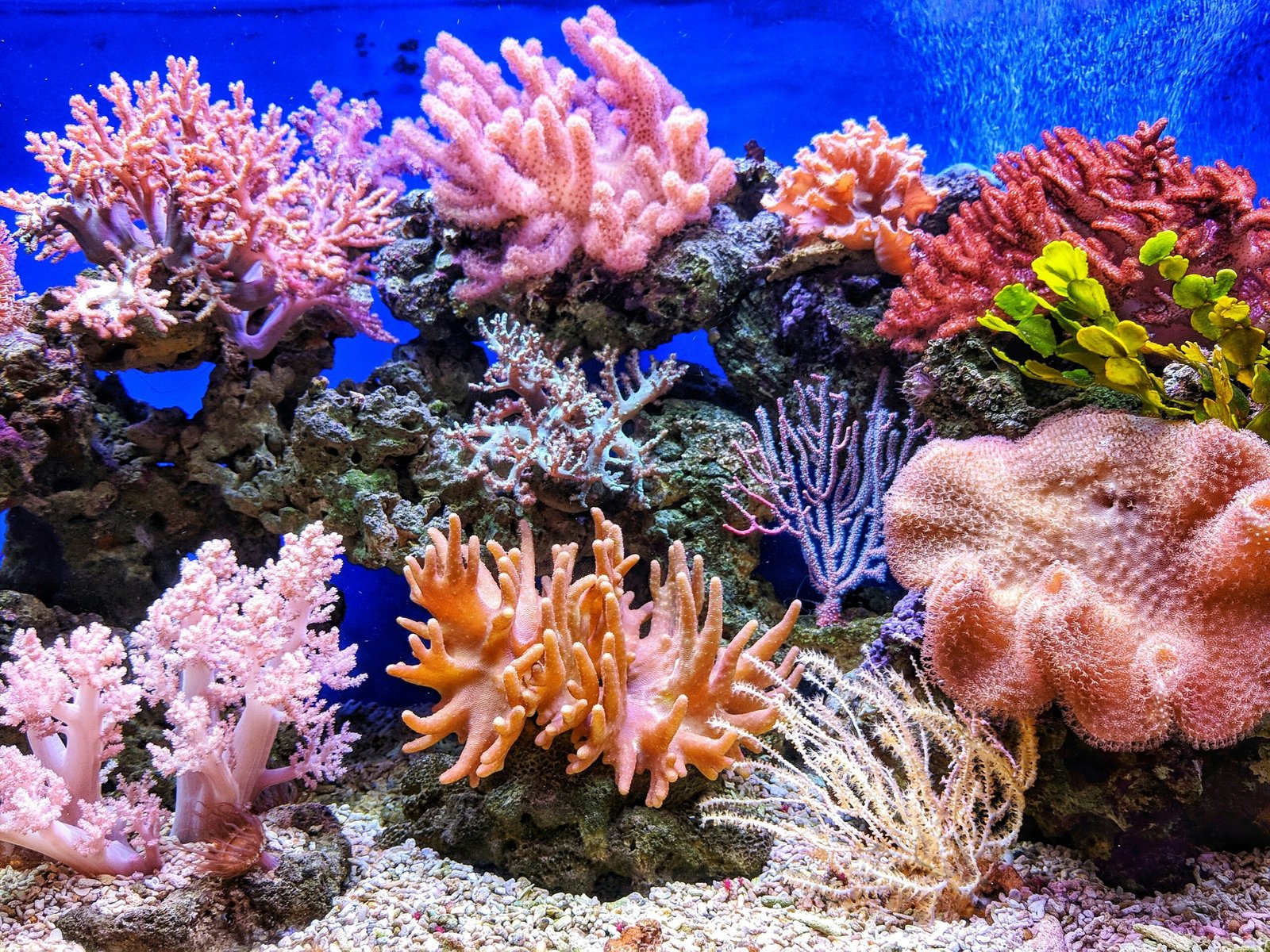Introduction to Coral Reefs
Coral reefs, often referred to as the “rainforests of the sea,” are intricate and diverse marine ecosystems found in tropical and subtropical oceans. They are composed primarily of coral polyps, tiny living organisms that form colonies. These polyps secrete calcium carbonate, which over thousands of years accumulates to create the robust and complex structures known as coral reefs. There are several types of coral reefs, including fringing reefs, which are directly attached to a shore, barrier reefs that run parallel to the coast but are separated by deeper water, and atolls, which are ring-shaped reefs that encircle a lagoon.
Coral reefs are predominantly located in shallow, warm waters between the Tropic of Cancer and the Tropic of Capricorn. Major reef systems include the Great Barrier Reef in Australia, the Mesoamerican Reef in the Caribbean, and the Coral Triangle in Southeast Asia. These regions provide optimal conditions for coral growth, such as clear water, abundant sunlight, and stable, warm temperatures.
The physical structure of coral reefs is both intricate and diverse, comprising different zones such as the reef crest, flat, and slope. Each zone hosts a variety of marine species, contributing to the reef’s overall biodiversity. The formation process of coral reefs is slow but continuous, as polyps grow and form new layers over old ones. This ongoing development provides habitats for countless marine organisms, from tiny plankton to large fish and marine mammals.
Understanding the unique formation and structure of coral reefs is crucial for appreciating their role in ocean health. These vibrant ecosystems not only support marine biodiversity but also offer numerous benefits, including coastal protection, sources of food, and opportunities for research and tourism. Their complexity and beauty make them indispensable components of the marine environment, highlighting the need for their conservation and protection.
Biodiversity Hotspots
Coral reefs are often referred to as the rainforests of the sea due to their remarkable biodiversity. These underwater ecosystems support an estimated 25% of all marine species despite covering less than 1% of the ocean floor. The complex structures of coral reefs provide both habitat and food for a vast array of marine life, making them crucial to the health and stability of oceanic ecosystems.
Among the myriad species that call coral reefs home are over 4,000 species of fish, 800 species of hard corals, and countless invertebrates such as mollusks, echinoderms, and crustaceans. Notable examples include the vibrant parrotfish, which play a critical role in reef health by grazing on algae, and the cleaner shrimp, which engage in mutualistic relationships with fish by removing parasites from their scales. Additionally, coral reefs support numerous species of marine plants, like seagrasses and algae, which contribute to the complex food webs sustained within these environments.
The ecological relationships within coral reefs are intricate and highly interdependent. For instance, the symbiotic relationship between certain fish and corals showcases the mutual benefits that arise within these ecosystems. Fish species such as the damselfish depend on corals for shelter, while their presence aids in the removal of algae that could otherwise smother coral polyps. This delicate balance underscores the importance of each species in maintaining the overall health of the reef.
Furthermore, coral reefs serve as critical breeding and nursery grounds for many marine species. Juvenile fish often find refuge within the nooks and crannies of the reef, which provide protection from predators and a steady supply of food. This early life stage support is vital for the sustainability of marine populations and, by extension, the broader oceanic food web.
In essence, the biodiversity supported by coral reefs is unparalleled, and their ecological significance cannot be overstated. The myriad species that depend on these vibrant ecosystems highlight the intricate and essential nature of coral reefs in maintaining the health and diversity of our oceans.
Economic Importance
Coral reefs play a pivotal role in supporting global economies by contributing significantly to various sectors such as fisheries, tourism, and coastal protection. These vibrant ecosystems serve as critical habitats for a multitude of marine species, which are integral to commercial and subsistence fishing industries. For instance, coral reefs contribute an estimated $6.8 billion annually to global fisheries, providing livelihoods for millions of people, particularly in coastal regions of developing countries.
Tourism is another sector that heavily benefits from healthy coral reefs. Destinations such as the Great Barrier Reef in Australia and the Maldives draw millions of tourists each year, generating substantial revenue for local economies. Activities such as diving, snorkeling, and eco-tourism not only offer unique experiences but also foster awareness and conservation efforts. In regions like the Caribbean, coral reef-related tourism is a major economic driver, accounting for a significant portion of GDP and employment opportunities.
Additionally, coral reefs offer natural coastal protection by acting as barriers that reduce wave energy, thus preventing erosion and protecting shorelines from storm surges and rising sea levels. This natural defense mechanism is crucial for safeguarding coastal infrastructure and communities, mitigating potential economic losses from natural disasters. For example, it is estimated that coral reefs provide around $9 billion annually in coastal protection benefits worldwide.
The financial ramifications of coral reef degradation are profound. The loss of reef structures can lead to the collapse of local fisheries, reduced tourism revenue, and increased vulnerability to coastal hazards. It is projected that the global economy could suffer losses amounting to billions of dollars annually if current trends in coral reef degradation continue. Therefore, the economic importance of coral reefs cannot be overstated, underscoring the need for concerted conservation and sustainable management efforts.
Natural Barriers Against Erosion
Coral reefs play a crucial role in acting as natural barriers that protect coastal regions from erosion, storm surges, and tsunamis. These vibrant underwater ecosystems form complex structures that dissipate wave energy, reducing the impact on shorelines. By absorbing up to 97% of the wave energy, coral reefs significantly diminish the force of incoming waves, thereby safeguarding coastal areas from erosion.
Scientifically, the structure of coral reefs contributes to their effectiveness as natural barriers. The rugged, three-dimensional formations created by reef-building corals slow down and break up waves, dispersing their energy before they can reach the shore. This process lessens the potential damage caused by storm surges and tsunamis, which can otherwise lead to severe coastal erosion and loss of human life and property.
Several case studies underscore the protective functions of coral reefs. For instance, during the 2004 Indian Ocean tsunami, areas shielded by healthy coral reefs experienced significantly less damage compared to regions where reefs had been degraded or destroyed. Similarly, in the Caribbean, the protective role of coral reefs against hurricanes has been well-documented. Research shows that coastal communities in Belize and the Bahamas have benefited from the presence of coral reefs, which have mitigated the effects of powerful storm surges.
The importance of these protective functions cannot be overstated. Coastal erosion not only threatens human settlements but also disrupts ecosystems and economies dependent on coastal resources. By serving as natural barriers, coral reefs help preserve beaches, prevent property damage, and protect human lives. The loss of these natural defenses due to coral bleaching, pollution, or other anthropogenic factors could lead to increased vulnerability of coastal regions to natural disasters, emphasizing the need for conservation and restoration efforts to maintain the integrity of coral reefs.
Coral reefs play a crucial role in regulating the ocean’s carbon cycle, contributing significantly to carbon sequestration. These vibrant ecosystems act as carbon sinks, absorbing carbon dioxide (CO2) from the atmosphere through the process of photosynthesis undertaken by the symbiotic algae known as zooxanthellae. This process not only helps in the growth of coral structures but also reduces the amount of CO2 in the atmosphere, thereby mitigating the greenhouse effect and contributing to global climate regulation.
Through the calcification process, corals convert dissolved CO2 into calcium carbonate (CaCO3), forming their skeletons. This transformation locks away carbon in a stable form for potentially thousands of years, making coral reefs essential players in the long-term sequestration of carbon. The reefs’ ability to store carbon helps maintain the balance of the ocean’s carbon cycle, which is integral to the health of marine ecosystems and the broader global climate system.
The interconnectedness of coral reefs with other marine ecosystems amplifies their impact on ocean health. Seagrass beds and mangrove forests, often found in proximity to coral reefs, also play significant roles in carbon sequestration. These ecosystems create synergistic relationships where each habitat supports the other, enhancing their collective ability to capture and store carbon. For instance, the structural complexity of coral reefs provides shelter and feeding grounds for numerous marine species, which in turn support the biodiversity and productivity of adjacent ecosystems.
Furthermore, the health of coral reefs is closely linked to the overall stability of marine environments. Healthy coral reefs support fisheries, protect coastlines from erosion, and maintain the diversity of marine life, which all contribute to the resilience of ocean ecosystems. Any decline in coral reef health can have cascading effects, disrupting these vital services and undermining the ocean’s capacity to sequester carbon effectively.
In essence, coral reefs are indispensable in the fight against climate change. Their role in carbon sequestration not only aids in regulating atmospheric CO2 levels but also ensures the sustainability of marine ecosystems. Protecting and preserving coral reefs is therefore critical for maintaining the health of our oceans and the stability of the global climate.
Medicinal Resources
Coral reefs are not only biodiversity hotspots but also treasure troves of medicinal resources. These vibrant ecosystems harbor a plethora of marine organisms, many of which possess unique biochemical compounds with significant medicinal potential. Scientists have been exploring coral reefs for decades, identifying various compounds that have led to the development of new drugs and treatments.
One notable example is the drug Ara-C, derived from the Caribbean sea sponge. Ara-C is used in the treatment of leukemia and lymphoma, showcasing the immense potential of marine-derived compounds in combating serious diseases. Another important discovery is the compound bryostatin, sourced from the bryozoan Bugula neritina. Bryostatin has shown promise in treating Alzheimer’s disease, providing hope for millions affected by this debilitating condition.
Ongoing research continues to uncover new potential treatments from coral reef organisms. For instance, the soft coral Sinularia has been found to produce compounds with anti-inflammatory properties, which could lead to new treatments for chronic inflammatory conditions. Additionally, researchers are investigating the potential of coral-derived compounds in developing novel antibiotics, crucial in the fight against antibiotic-resistant bacteria.
The potential for future discoveries in coral reef ecosystems is vast. Marine bioprospecting, the process of exploring marine organisms for novel compounds, is an area of active research. Scientists are particularly interested in the unique chemical defenses evolved by coral reef species to survive in their complex and competitive environments. These chemical compounds could hold the key to new treatments for a wide range of human ailments, from cancer to viral infections.
In conclusion, coral reefs play a crucial role not only in ocean health but also in advancing medical research and drug development. Protecting these invaluable ecosystems is essential, as they hold the promise of future medicinal breakthroughs that could significantly benefit human health. The ongoing exploration and study of coral reefs underscore their importance as a source of novel and life-saving medical resources.
Threats to Coral Reefs
The health of coral reefs is under severe threat from a multitude of factors, many of which are exacerbated by human activities. Climate change stands out as one of the most significant threats. Rising sea temperatures cause coral bleaching, a phenomenon where corals expel the symbiotic algae living in their tissues, leading to a loss of color and vital nutrients. According to a 2020 study by the National Oceanic and Atmospheric Administration (NOAA), over 75% of the world’s coral reefs experienced bleaching in the past 30 years.
Ocean acidification, another consequence of increased carbon dioxide emissions, reduces the availability of calcium carbonate, which corals need to build their skeletons. The Intergovernmental Panel on Climate Change (IPCC) projects that if current CO2 emission trends continue, ocean pH levels could drop by 0.3 to 0.4 units by the year 2100, significantly impeding coral growth and resilience.
Overfishing is another critical threat. The removal of key species disrupts the balance of the reef ecosystem. For example, the depletion of herbivorous fish can lead to unchecked algae growth, which competes with corals for space and light. The Food and Agriculture Organization (FAO) notes that 90% of fish stocks are either fully exploited or overexploited, indicating a severe strain on marine biodiversity.
Pollution from agricultural runoff, plastic debris, and untreated sewage contributes to the degradation of coral reefs. Nutrient-rich runoff can lead to harmful algal blooms, while plastic waste can physically damage corals and introduce toxins into the marine environment. A report by the United Nations Environment Programme (UNEP) highlights that approximately 8 million tons of plastic enter the oceans every year, posing a substantial threat to coral reefs.
Natural events such as hurricanes and cyclones also impact coral reefs, albeit to a lesser extent compared to human-induced threats. These events can cause physical damage to reef structures and increase sedimentation, which can smother corals and hinder their growth.
In summary, coral reefs face a combination of threats that jeopardize their health and survival. Addressing these challenges requires coordinated global efforts to mitigate climate change, regulate fishing practices, reduce pollution, and protect these vital ecosystems for future generations.
Conservation and Restoration Efforts
Conservation and restoration initiatives play a pivotal role in safeguarding coral reefs, which are essential to ocean health. Governments, Non-Governmental Organizations (NGOs), and local communities are at the forefront of these efforts, each contributing uniquely to the preservation and rehabilitation of these underwater ecosystems. Governmental agencies often enact regulations to limit harmful activities, such as overfishing and coastal development, that threaten coral reefs. Additionally, they establish marine protected areas (MPAs) to provide safe havens where coral reefs can thrive without human interference.
NGOs like the Coral Restoration Foundation and Reef Check engage in on-the-ground activities that directly contribute to coral reef conservation. These organizations often conduct coral planting and monitoring programs to revive damaged reefs. For instance, the Coral Restoration Foundation has successfully restored over 25,000 corals in the Florida Keys National Marine Sanctuary. These efforts are pivotal for not only restoring coral structures but also for enhancing biodiversity and resilience against climate change.
Local communities also play a critical role in coral reef conservation. Indigenous and coastal communities often possess traditional knowledge and practices that have safeguarded coral reefs for generations. Empowering these communities through education and involving them in conservation projects can lead to more sustainable and culturally sensitive approaches. For example, community-managed marine areas in Fiji have shown significant success in reef recovery and fish population increases.
Emerging technologies are revolutionizing coral reef conservation. Innovations such as coral nurseries, genetic engineering, and artificial reefs offer new methods for restoring and protecting these ecosystems. Scientists are also utilizing satellite and drone technology to monitor reef health and track changes over time, enabling more informed and timely conservation actions.
Ultimately, the preservation of coral reefs requires global cooperation. International agreements, such as the Paris Climate Agreement, aim to reduce carbon emissions, which is essential for mitigating the effects of climate change on coral reefs. Individual actions, such as reducing carbon footprints and supporting sustainable seafood choices, also contribute to the broader effort. By working together, we can ensure the survival of coral reefs and the myriad of life forms they support.
